Then I found similar frames that had chevron. And I swooned even more. And nearly fainted at the price tags. But oh... they are SO cute!
For the record, I have since found out that the reason people charge so darn much for these frames is that they are a pain in the rear. Lesson learned.
If you'd like to be brave like me and attempt this frame on your own, here's what I did to create this beauty. I apologize for the phone pictures, and the lack of some pictures for some of the steps. I'm no pioneer woman or DIY guru. I'm a mommy blogger with little time for anything other than changing diapers and cleaning up spilled milk. Moving on.
You'll need:
- 1/2 inch MDF board. We purchased ours at Lowe's. An entire sheet will make you roughly 10 backboards for this frame, meaning you could make enough frames to have a gallery wall. If you were that crazy to attempt it :) It costs about $30 for the whole sheet. Rumor has it that some of the home improvement stores will help you cut lumber. We never asked, although I wish we would have (you'll find out why later).
- a cute frame from the Hob Lob. I chose the one I used when it was 50% off, making it $10. It's an 8x10 opening.
- spray paint, and lots of it. If you've read any tutorials online about spray painting furniture, you've learned two things: Kilz primer is the best, and Krylon spray paint is the only way to go. I actually learned the hard way on the primer part, and wasted some money using a different brand. Go Kilz or go home. For this particular frame I used 1 can of Kilz primer, 2.5 cans of Krylon flat white, and a little less than 1 can of Krylon flat black. My favorite tutorials on how to glaze/spray paint furniture are found on All Things Thrifty.
- sand paper and sanding block. For my sanding block (this is basically like a big thick sponge that has sand paper on it-- it's a lot easier to handle instead of regular sand paper) I used 320 fine grit, Then when I used the hand sander I used 220 grit, and then I realized I needed 320 grit to really distress it deeply (if that is even a term?).
How I made this darn thing:
-Cut out a 24"x24" square from the MDF. I don't have pictures of this step unfortunately. I asked Drew to do the sawing part. Saws scare me, even though there are tons of women bloggers who seem to be perfectly fine handling their own power tools. I am not one of those women bloggers, so I left the power tools to my man. For this particular frame, I wanted my backboard to be 24"x24". I had measured that size for the wall I am putting this frame on. Drew cut out my square (he actually cut straight across the board, thinking that the extra .25 inches wouldn't hurt since it's just a backboard. Remember this fact later.) He then cut out a rectangle in the middle of the square, since I wanted to be able to change out my pictures from my frame. I've since seen a tutorial for a similar frame where they don't cut out an opening, but rather just hang the stacked frame on the baseboard. Either way gets the end results. Do whatever is easier for you.
-Sand the edges. I didn't want my edges too rounded (they'll get more rounded when you distress later), so Drew did 2-3 passes with his palm sander on the edges and top of the frame, just to smooth things out. He used 220 grit for this.
-After he sanded I wiped the frame down with a damp cloth to get all of the dust off. Then I started priming. I used Kilz spray primer to begin with, and then tried to finish (I was making two baseboards at a time) with a different brand. I'm here to tell you, Kilz worked WAY better and covered much more evenly. GET KILZ spray primer as if your life depends on it. You'll thank me later. I let my primer cure 1 day, although I'm pretty sure that wasn't necessary.Also, for some reason this primer made the wood really rough. I used my sanding block to smooth the surface out after I had primed it. Here's what it looked like post cutting, sanding, priming:
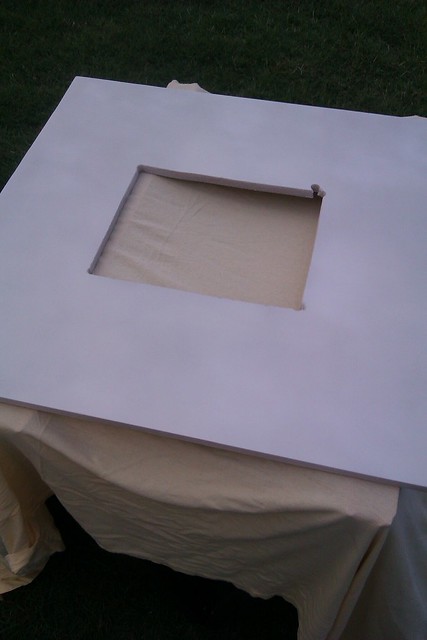
- Next I taped off the chevron print. I just have to laugh at this instruction. It seems so easy, right? I mean, all the tutorials for chevron prints on rugs, walls, frames, etc, on pinterest just gloss over this step like it's an easy walk in the park and you'll have no heartburn. I'm here to tell you that I had both heart burn, internal strife and marital quarrels over this stupid print. I almost threw in the towel on it altogether.
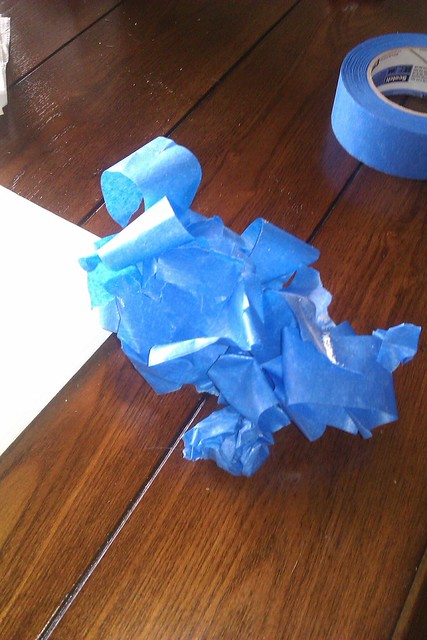
I threw away a LOT of painters tape before realizing that I didn't have the right dimensions for my board
I will come clean and say that geometry has never been my strong point. I did eventually figure it out. Remember how Drew had left .25" on the MDF board at the beginning? After 2 days of me trying to figure out how to tape off chevron print on a 24.25" board, I realized that my measurements would always be off because (a)I had tried to use 1.5" painters tape and (b) because I was not dealing with a perfect square. Once I realized those two things, my heartburn subsided and I was able to move on relatively quickly. Drew simply cut off the extra .25" and I was able to get going with the design.

my graph being drawn.

Now you need to measure your stripes out. The easiest way I found to do this was to find the middle point, and then measure 2" up till I reached both corners. Hopefully that makes sense. The width of the stripe should be 2" from any place that you measure, except for the points, which will measure 3" (this is all shown on the graph above). Writing this makes me realize how hard it is to write these tutorials... I feel like I'm not making any sense. I think once you get going you'll understand what I mean. This is going to take a while, and you want it to be even, so don't rush it.
-After all of my board was a big grid with gently marked pencil lined chevron, I taped over the stripes that I wanted to be the base color. You will need to be accurate, and you'll also need a sharp box cutter or straight edge that you can use to cut away any tape pieces if they are laying over (like if your tape overlaps at the tip of the point and you need to cut away the tape to make a perfect point).
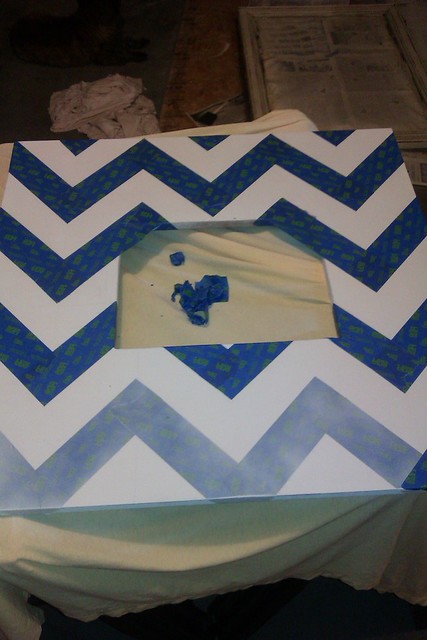
All taped up and ready for the second color!
One thing to note: on the outside edges of the MDF, even after sanding it was still pretty rough, which meant that my tape didn't hold onto the edges that well. At this point I was just ready to be done with my frame, so I didn't really care if it bled on the edges. If you care, then you may want to figure out a way to make the tape stay better than I was able to do.
-Once it's taped, make sure you rub the edges of the tape hard so that they are adhered as tightly as possible to the wood. Spray your top coat until it is even. I tried to not get too diagonal when I was spraying near the edges of the tape-- I figured it wouldn't hurt trying to help not getting it underneath it. For the most part, the tape held up well and I had only 2-3 spots where it lightly seeped under. Barely noticeably really.
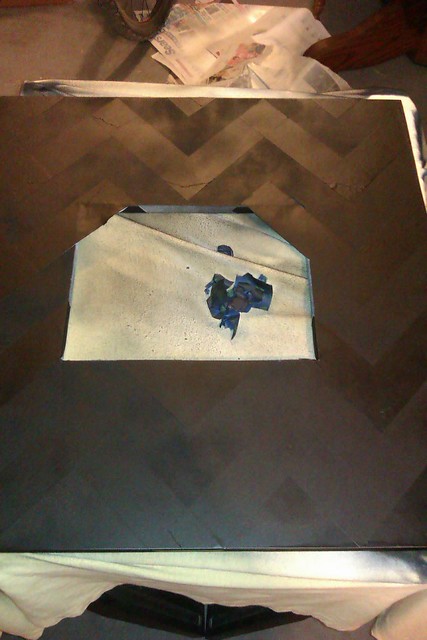
before I took the tape off
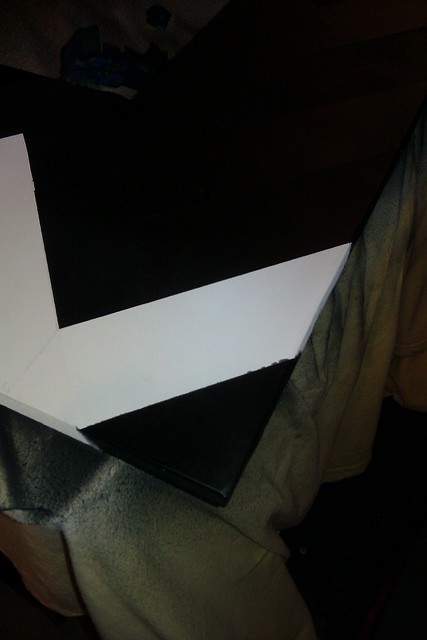
Can you see where it seeped just a little? This is easily removed when you distress your frame later

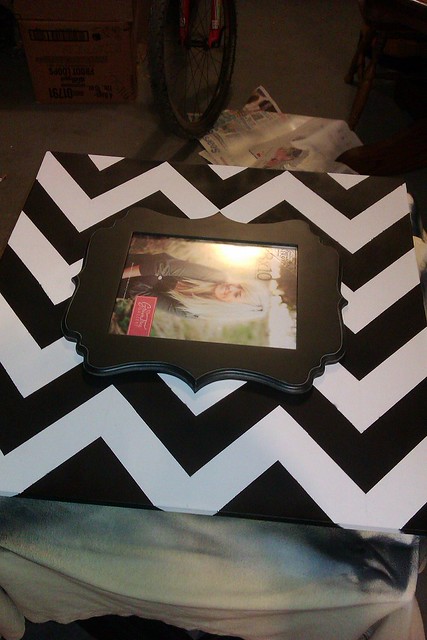
before distressing. It made me nervous with how bold it was... definitely glad to distress it a bit!
-You'll want your paint to cure (dry) for at least 24 hours before distressing. I waited 48. Just to be sure. I didn't want all that hard work to smear or get ruined after getting impatient. When I googled "distressing with sandpaper" I got several websites. None of which were too incredibly helpful. This left me a bit nervous about the last part of the process. I used 220 grit at first, as that seemed to be the universal grit used for distressing things. And I marched myself out to the garage to have a go at it. I took the paper to the edges, and then lightly rubbed over the entire thing, focusing on a few areas to make sure the top of it had a worn look too. I felt like it was still needing more distressing after I went over the whole thing with 220 grit, so I took out the 320 grit. At first, I freaked. It looked kind of scratchy. But after you keep going, it really wears down well, and you're left with some bare spots. I like bare spots. Know that the whole sanding process is a matter of preference. You can distress as little or as much as you want. That's the beauty of doing things yourself.
Once I was sure it was distressed like I wanted, I wiped the frame down really well with a damp cloth. I let the frame dry (it wasn't really wet, but it wasn't completely dry either. Be sure not to use too much water in your cloth, as MDF doesn't do well with getting wet). I then sprayed the whole frame down with Krylon clear acrylic spray paint. It's a non-yellowing finish. It was the satin sheen, which I felt like really gave the frame a nice finish. It didn't make it too glossy at all.
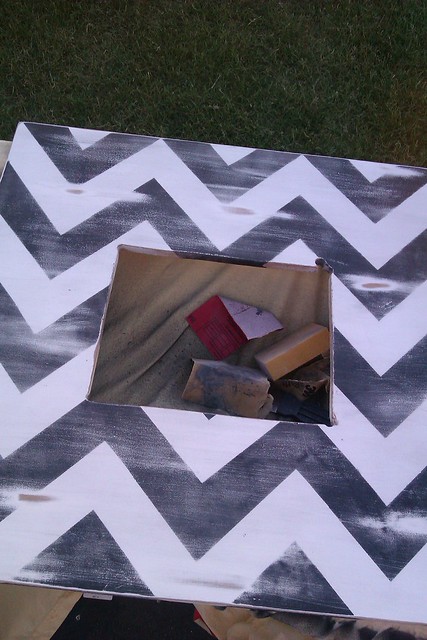
All sanded, sealed and ready for the stacked frame.
-Once your frame is sanded and finished with your clear coat, you'll want to measure your center stacked frame for the middle, so that it's perfectly centered. Once it's centered you'll want to mark the edges, and then carefully use gorilla glue to attach the frame permanently to the baseboard. Drew did this step for me. You want to make sure you don't use so much glue that it seeps out of the sides, as gorilla glue does not dry on clear. While the glue is drying make sure you stack something heavy on top of the frame and baseboard so that it attaches securely.
-And this is the finished product. I apologize for all of these pictures being phone pictures. After getting so frustrated at the beginning of the project, the last thing I wanted to do was whip out my nice camera and have to edit pictures too. ha! Drew used a screw and put it in a stud. He then hung the inside lip on the screw, making sure there was a little carving in the lip for the head of the screw. Hopefully that makes sense... I didn't take any pictures of it.... sorry about that.
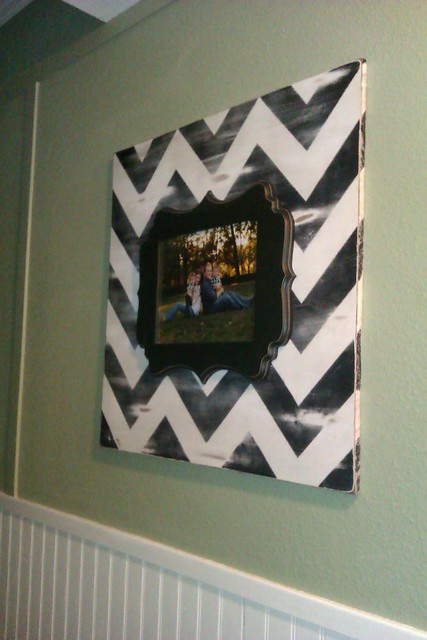
- MDF: $30
- Spray paint/Primer: ~$30
- sand block: $4
- clear coat: $4
TOTAL: $68
You save up to half of what it costs online. But you probably save a lot of sanity by just purchasing it outright from an etsy seller. I don't know, it's a tough call. Considering I have two young kids at home and I like getting along with my husband, I'm thinking etsy wins out next time. Not to discourage any of you from embracing your inner Martha Stuart and creating your very own frame masterpiece ;)
This post is linked up with the following link-ups:
Not Just a Housewife
Milk and Cuddles


















